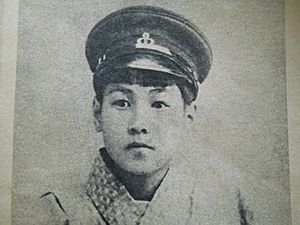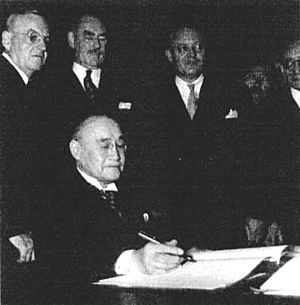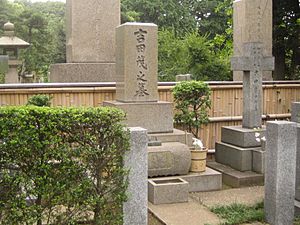Shigeru Yoshida facts for kids
Quick facts for kids
Shigeru Yoshida
Junior First Rank
|
|
|---|---|
| 吉田 茂 | |

Yoshida c. 1950
|
|
| Prime Minister of Japan | |
| In office 15 October 1948 – 10 December 1954 |
|
| Monarch | Shōwa |
| Governor | |
| Deputy | Jōji Hayashi Taketora Ogata |
| Preceded by | Hitoshi Ashida |
| Succeeded by | Ichirō Hatoyama |
| In office 22 May 1946 – 24 May 1947 |
|
| Monarch | Shōwa |
| Governor | Douglas MacArthur |
| Deputy | Kijūrō Shidehara |
| Preceded by | Kijūrō Shidehara |
| Succeeded by | Tetsu Katayama |
| Member of the House of Representatives for Kochi At-large District |
|
| In office 26 April 1947 – 23 October 1963 |
|
| Member of the House of Peers | |
| In office 19 December 1945 – 3 May 1947 |
|
| Personal details | |
| Born | 22 September 1878 Yokosuka, Kanagawa, Empire of Japan |
| Died | 20 October 1967 (aged 89) Tokyo, Japan |
| Political party | Liberal Democratic (1955–1967) |
| Other political affiliations |
Liberal (1945–1948) Democratic Liberal (1948–1950) Liberal (1950–1955) |
| Spouse |
Yukiko Makino
(m. 1909; died 1941) |
| Children | 4, including Ken'ichi |
| Relatives |
|
| Alma mater | University of Tokyo |
| Signature |  |
Shigeru Yoshida (吉田 茂, Yoshida Shigeru) (born September 22, 1878 – died October 20, 1967) was an important Japanese diplomat and politician. He served as the Prime Minister of Japan two times: first from 1946 to 1947, and then for a longer period from 1948 to 1954. He is known as one of Japan's longest-serving prime ministers after World War II.
Contents
Early Life and Education
Shigeru Yoshida was born in Tokyo on September 22, 1878. He was the fifth son of Tsuna Takeuchi, who was a political activist and a former samurai. A samurai was a type of warrior in ancient Japan.
When Shigeru was young, he was adopted by Kenzō Yoshida and his wife Kotoko. Kenzō was a rich merchant and also a former samurai. Shigeru inherited a lot of money from Kenzō when he passed away in 1889.
Shigeru went to different schools. He studied at the prestigious Peers' School, which prepared young people from important families for public service. He also studied law at Tokyo Imperial University and graduated in 1906. Soon after, he joined Japan's diplomatic service.
Diplomatic Career
Yoshida's career as a diplomat began in China in 1906. He worked in different cities there, like Tianjin and Shenyang. Later, he worked in Italy, and then in Korea, which was under Japanese rule at the time.
In 1916, he moved to the Japanese embassy in the United States. In 1919, he was part of the Japanese team at the Paris Peace Conference, which helped end World War I. He then worked in the Japanese embassy in the United Kingdom starting in 1920.
He became a minister to Sweden, Norway, and Denmark in 1928. Later that year, he became the deputy foreign minister for Japan. From 1930 to 1936, he was the ambassador to Italy. Then, from 1936 to 1938, he was the ambassador to the United Kingdom. After this, he retired from being a diplomat.
During World War II
Even though Yoshida supported Japan having more influence in China, he was strongly against Japan going to war with the United States and the United Kingdom.
During World War II, he did not hold an official government job. However, he worked hard to try and stop the war from happening. He also tried to help end the war early by working with Prince Fumimaro Konoe. In April 1945, near the end of the war, he was arrested and briefly put in prison because of his connection with Prince Konoe.
Becoming Prime Minister
After Japan surrendered in August 1945, the Allied forces (mainly the United States) took control of the country. In November 1945, a new political group called the Liberal Party was formed, and Yoshida joined it.
In the 1946 election, the Liberal Party won. Their leader, Ichirō Hatoyama, was supposed to become prime minister. However, the Allied authorities stopped Hatoyama from taking the job. So, Shigeru Yoshida was chosen instead. He became the 45th Prime Minister of Japan on May 22, 1946. The Allied forces liked him because he understood Western countries and had good relationships with the United States and Britain.
He was replaced by Tetsu Katayama in 1947. But he returned to the job and became the 48th Prime Minister on October 15, 1948.
In 1951, he signed the Treaty of San Francisco. This was a peace treaty with the Allied countries that officially ended World War II for Japan. It also meant that the Allied occupation of Japan would end in 1952.

Under Yoshida's leadership, Japan started to rebuild its factories and businesses that were destroyed in the war. He focused on making Japan's economy grow very fast. Many of his ideas about how Japan should grow its economy are still important today.
Yoshida remained prime minister through three more elections. However, some members of his party became unhappy with his leadership. This led many of them to leave his party and join a new one. Because of this, his government had to resign on December 7, 1954. He was replaced by Ichirō Hatoyama on December 10, 1954. Yoshida continued to be a member of the Japanese parliament until he retired in 1963.
The Yoshida Doctrine
The "Yoshida Doctrine" was a special plan that Japan followed starting in 1951, under Yoshida's leadership. This plan had a few main parts:
- Japan would focus on rebuilding its own economy.
- Japan would rely heavily on its security alliance with the United States for protection. This meant Japan would keep its own military small.
- Japan would focus on using diplomacy and trade to deal with other countries.
This plan helped Japan recover and grow strong economically after the war. Many historians believe it was a very successful strategy for Japan.
Later Years and Family
Shigeru Yoshida passed away in 1967. He was buried in the Aoyama Cemetery.
In 1909, Yoshida married Makino Yukiko. They had four children together. Two of his grandchildren also became important figures: Tarō Asō served as the Prime Minister of Japan from 2008 to 2009, and Nobuko Asō married a prince.
Honors
Shigeru Yoshida received many important awards and honors during his life and after his death, including:
- Grand Cordon of the Order of the Rising Sun (1940)
- Grand Cordon of the Order of the Chrysanthemum (1964)
- Collar of the Order of the Chrysanthemum (awarded after his death in 1967)
See also
 In Spanish: Shigeru Yoshida para niños
In Spanish: Shigeru Yoshida para niños




